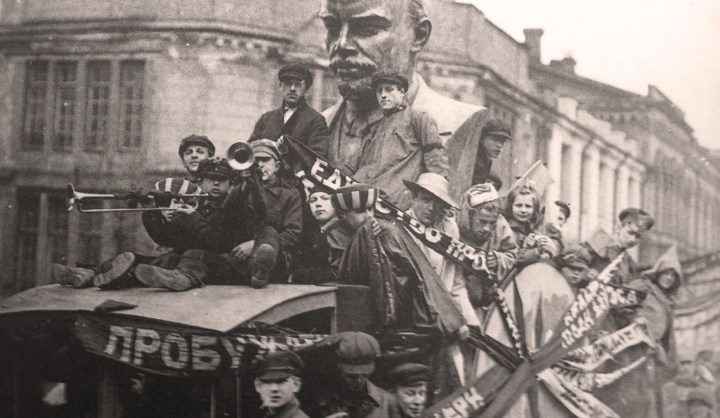World
May Day: Labouring under some global (dis)illusions

May Day is the global commemoration of the importance of workers, except for America and Canada. Curiously, May Day was first proposed in America in the wake of growing labour strength and efforts by industry to hold it down. But American Labor Day comes at the beginning of September, and increasingly it is the holiday that marks the end of summer and the beginning of the school term, instead of the struggles of unions to gain recognition and place in the country’s economy. J. BROOKS SPECTOR takes a look.
For decades, the multitudes carrying out official celebrations of May Day became a fixture of the communist regimes of Eastern Europe, China and the Soviet Union. And, over the years, of course, massive May Day parades by unions and their political partners and supporters were held in major western capitals as well. While the commemoration began in the United States, the holiday to honour workers is now held the first week of September in America and Canada, and more on that curious history in a minute.
Throughout the Cold War, at least from Moscow, the pictures in the newspapers or on television or around the world on May Day always seemed to feature those menacing military rockets rolling across Red Square, borne on giant trucks as well as vast formations of soldiers marching lock step, carrying their well-polished assault rifles at port arms. Inevitably, the news coverage would zoom in on Stalin, Khrushchev and the rest, standing at attention, high up above the crowds, on a balcony of the Lenin Mausoleum, taking public satisfaction at the full weight of Soviet military prowess.
For some, such marches were a tangible demonstration of the success of the international socialist project. The missiles, the inevitable huge red banners and flags, the heroic anthems booming out as a sound track, all made a vivid display of the heroic might of the East. The East was indeed red, just like the anthem, and its inexorable historical triumph was inevitable, it seemed.
For those in the West, of course, these same vast demonstrations were read rather differently. From that perspective, the demonstrations were a palpable threat to the US and the rest of NATO – especially since those mass demonstrations seemed tied closely with the historical demands of workers around the world. In many western cities, labour federations drew upon the enthusiasm of their members, their supporters and the adherents of the various socialist or communist parties to bring off marches that would similarly demonstrate the power of the workingman.
But where did all this energy come from originally? And why is American Labor Day on the first Monday in September instead of the First of May like pretty much everywhere else? Curiously, the original proponent of a day to commemorate the worker remains in dispute. According to some records, Peter McGuire, an eventual co-founder of the American Federation of Labor (AF of L), then the general secretary of the Brotherhood of Carpenters and Joiners, was the first person to propose a day to honour those “who from rude nature have delved and carved all the grandeur we behold.”
In an historical note, the AF of L was the first lasting national labour federation, founded in 1886 on the basis of a dispute within the earlier Knights of Labor. The AF of L eventually brought together an major array of craft unions under one umbrella organisation. The national pre-eminence of the AF of L was eventually challenged by the more aggressive and more radical Council of Industrial Organisations, organised from unions that comprised all of the workers in a whole industry like coal mining, rather than around specific workers in a trade like carpenters or machinists. The rivalry between the two federations continued until the two competing groups finally merged in 1955, bringing most American unions into one national federation – and marking the high water mark of the unionisation movement in America.
But Peter McGuire’s place as the original exponent of Labor Day has been challenged by recent research that points to another “McGuire”, one Matthew Maguire (without a capital “G”), a machinist, who it is now believed actually first pushed the holiday. This second McGuire, who eventually became the secretary of Local 344 of the International Association of Machinists, apparently actually proposed the holiday in 1882 while he was secretary of New York’s Central Labor Union.
This Central Labor Union adopted the first Labor Day proposal and appointed a committee to plan a demonstration and picnic – and with this the first Labor Day holiday was marked on 5 September 1882, in New York City. By 1884, the first Monday in September was formally adopted as that organisation’s holiday and the Central Labor Union began encouraging other labour bodies across the nation to follow their example to celebrate a “workingmen’s holiday.” Given the tenor of the times, and growing power of unions, this idea soon spread to many American industrial centres beyond New York City.
According to the US Department of Labor’s own history of Labor Day, “The form that the observance and celebration of Labor Day should take was outlined in the first proposal of the holiday — a street parade to exhibit to the public ‘the strength and esprit de corps of the trade and labor organisations’ of the community, followed by a festival for the recreation and amusement of the workers and their families. This became the pattern for the celebrations of Labor Day. Speeches by prominent men and women were introduced later, as more emphasis was placed upon the economic and civic significance of the holiday. Still later, by a resolution of the American Federation of Labor convention of 1909, the Sunday preceding Labor Day was adopted as Labor Sunday and dedicated to the spiritual and educational aspects of the labor movement.”
Meanwhile, while Labor Day was just getting started as a celebration, on 4 May 1886, the Haymarket Massacre of striking workers in Chicago had taken place. The massacre came as the aftermath of a bombing set off in the midst of a peaceful labour demonstration in Haymarket Square in Chicago. The events had begun as a rally in support of workers who striking for an eight-hour day and in reaction to the killing of several workers by police a day earlier. An unknown person threw a dynamite bomb at police as they were in the process of dispersing the public meeting. The bomb blast and ensuing gunfire led to the deaths of seven police officers and at least four civilians, while scores of other people were wounded in the ensuing melee.
In the context of the growing militancy of American labour unions, there were growing official concerns commemorating Labor Day on the first of May could easily mutate into a commemoration of the Haymarket Massacre. According to the US Department of Labor’s history of the holiday, “The first state bill was introduced into the New York legislature, but the first to become law was passed by Oregon on February 21, 1887. During the year, four more states — Colorado, Massachusetts, New Jersey, and New York — created the Labor Day holiday by legislative enactment. By the end of the decade, Connecticut, Nebraska, and Pennsylvania had followed suit. By 1894, 23 other states had adopted the holiday in honor of workers, and on June 28 of that year, Congress passed an act making the first Monday in September of each year a legal holiday in the District of Columbia and the territories.”
Then, following the deaths of a number of workers at the hands of the US military and US Marshals during the Pullman Strike, the American Congress unanimously voted to approve rush legislation that made Labor Day a national holiday and then-President Grover Cleveland signed it into law just six days after the strike finally ended. The September date originally chosen by the CLU of New York and observed by many of the nation’s trade unions for the past several years was thus selected, rather than the already-widespread International Workers’ Day, apparently because President Cleveland was concerned observance of the latter would be associated with the nascent Communist, Syndicalist and Anarchist movements that, though separate from one another (and often battling each other), had already rallied to commemorate the Haymarket Massacre on International Workers’ Day.
Meanwhile, the first day of May had already been chosen as the date for International Workers’ Day by the assembled socialists and communists attending the meeting of the Second International to commemorate the fourth of May Haymarket Massacre. This meeting of the Second International had taken place in Paris in 1889. In accord with a proposal from one of the delegates, Raymond Lavigne, who called for international demonstrations to mark the 1890 anniversary of the Haymarket protest, and, in 1891, May Day was formally recognised as an annual event at the International’s second congress.
Subsequently, in 1904, the International Socialist Conference called upon all Social Democratic Party organisations and trade unions of countries worldwide “to demonstrate energetically on May First for the legal establishment of the 8-hour day, for the class demands of the proletariat, and for universal peace,” adding it was “mandatory upon the proletarian organisations of all countries to stop work on May 1, wherever it is possible without injury to the workers.”
The South African History Archive notes that “The first recorded celebration of May Day in South Africa is reported by Ray Alexander to have taken place in 1895 which was organised by the Johannesburg District Trades Council. The next occasion was the visit of British labour and socialist leader Tom Mann, who came to South Africa in 1910. Mann, like Kier Hardie before him, criticised the South African Labour Party (SALP) for its neglect of African workers, and urged the white labour movement to begin to think seriously of organising among African workers. His visit inspired a mood of international worker solidarity and culminated in a mass May Day procession in which all sections of the labour movement participated.” By the late 1980s, COSATU had successfully generated enormous public pressure for the country to observe May Day as a paid holiday for workers.
Of course a great irony in America as far as Labor Day goes is that it now has, increasingly, become less and less associated with unions and the workers, and, more and more as a way to mark the effective end of the summer vacation season; the chance for one last run to the beach; a family barbeque (braai to South Africans); a range of highly visible sports events; and the need for students (and their parents) to steel themselves for the beginning of the new school year. In years gone by, a massive rally on Labor Day in Detroit – “home” of the heavily unionised automobile manufacturing industry – was a highly visible, traditional event, often addressed by the head of the United Auto Workers and frequently attended, at least for Democrats, by senior politicians and sometimes even presidents.
This on-going, increasing evolution of Labor Day into a very different kind of holiday than its origins would have deeply disheartened the writer’s grandfather. He was a staunch union official – and an early organiser for the Amalgamated Meat Cutters and Butcher Workmen of North America, from back in the 1930s, when organising the unionisation of stores and factories could be physically dangerous business for union organisers. Yes, he loved his two weeks at the beach every year and his ocean fishing trips, but Labor Day – and the union movement – was always sacrosanct for him.
In a further irony, in what almost certainly is another part of efforts to generate more popular support for Vladimir Putin’s new, more assertive foreign policy adventures in Ukraine and Crimea, for the first time since 1991, a non-socialist Moscow was the scene for a major May Day parade. There were crowd estimates of around 100,000 people at the event, although some early government estimates had predicted that a million would show up for this event. Nevertheless, a long stream of marchers carried banners emblazoned with slogans such as, “I’m proud of my country,” “Let’s go to Crimea for vacation,” and “Putin is right,” together with those now-ubiquitous blue, red and white Russian flags, rather than the earlier standard red ones.
Also on May Day, Putin made a further effort to reach back to tap into an apparently growing nostalgia for the old Soviet Union when he gave out “Hero of Labor” awards at a Kremlin ceremony, following the actual march. Such awards had originally been established back in Stalin’s time and had been discontinued when the Soviet Union collapsed. The awards were brought back in 2013.
Elsewhere on the globe, there were marches in Istanbul, Turkey, where scores of protestors against the current government were injured in clashes with police. In Istanbul’s Taksim Square, police repelled demonstrators with tear gas and water cannon and demonstrators retaliated by using slingshots to attack the police. Taksim Square continues as a symbol of Turkey’s labour movement. In 1977, police killed some 34 people in that square during a May Day event when shots were fired into the crowd from a nearby building.
There were also significant May Day rallies in other places as well. In Havana, Cuba, marchers carried banners honouring Fidel and Raul Castro, Che’ Guevara, as well as the late President Hugo Chavez of Venezuela. Protesting the on-going economic austerity measures in Greece, some 15,000 people rallied for their May Day march; thousands of workers marched in Bangladesh to protest labour conditions; in Cambodia, auxiliary police attacked a crowd of around a thousand demonstrators; thousands marched in Manila in the Philippines to protest wage levels and the hiring of temporary employees; there were marches in various German cities; and several thousand people rallied in a rain-soaked Paris as well. And in Tehran, Iranian President Hassan Rouhani told thousands that he supports the establishment of unions that would be “free of any interference by the state.” His predecessor had earlier dissolved most unions, leaving just a few toothless labour organisations.
And, of course, in South Africa, there were various rallies on behalf of the day, events that effectively became campaign pep rallies for the increasingly troubled tripartite alliance. But it is a fair bet more people had a relaxed braai with family and friends, or a leisurely day around the house, than who participated in those formally organised rallies around the country.
Increasingly, the commemoration of May Day seems to be less and less a holiday specifically to honour the worker, and more and more a vehicle for various political motives. And this may also reflect the changing nature of unions in a global economy where the unions continue to recede in importance. But in saying this, if he could hear it, the author’s grandfather would definitely not be pleased. DM
Photo: May Day parade in newly formed Leningrad, 1924.
Read more:
- The History of Labor Day – Labor Day: How it Came About; What it Means at the US Department of Labor website
- Russia revives May Day parade; violence in Turkey at the AP
- The History of May Day in South Africa at SA History.org
- Trachtenberg A. (2002), ‘The History of the May Day’
- South African History, by ‘Congress of South African Trade Unions (COSATU)’
- Moscow May Day parade lauds Putin as more Ukraine buildings seized at Reuters
- Moscow revives Red Square May Day parade at USA Today
- Photos: May Day and International Labour Day at Canada.com


















 Become an Insider
Become an Insider